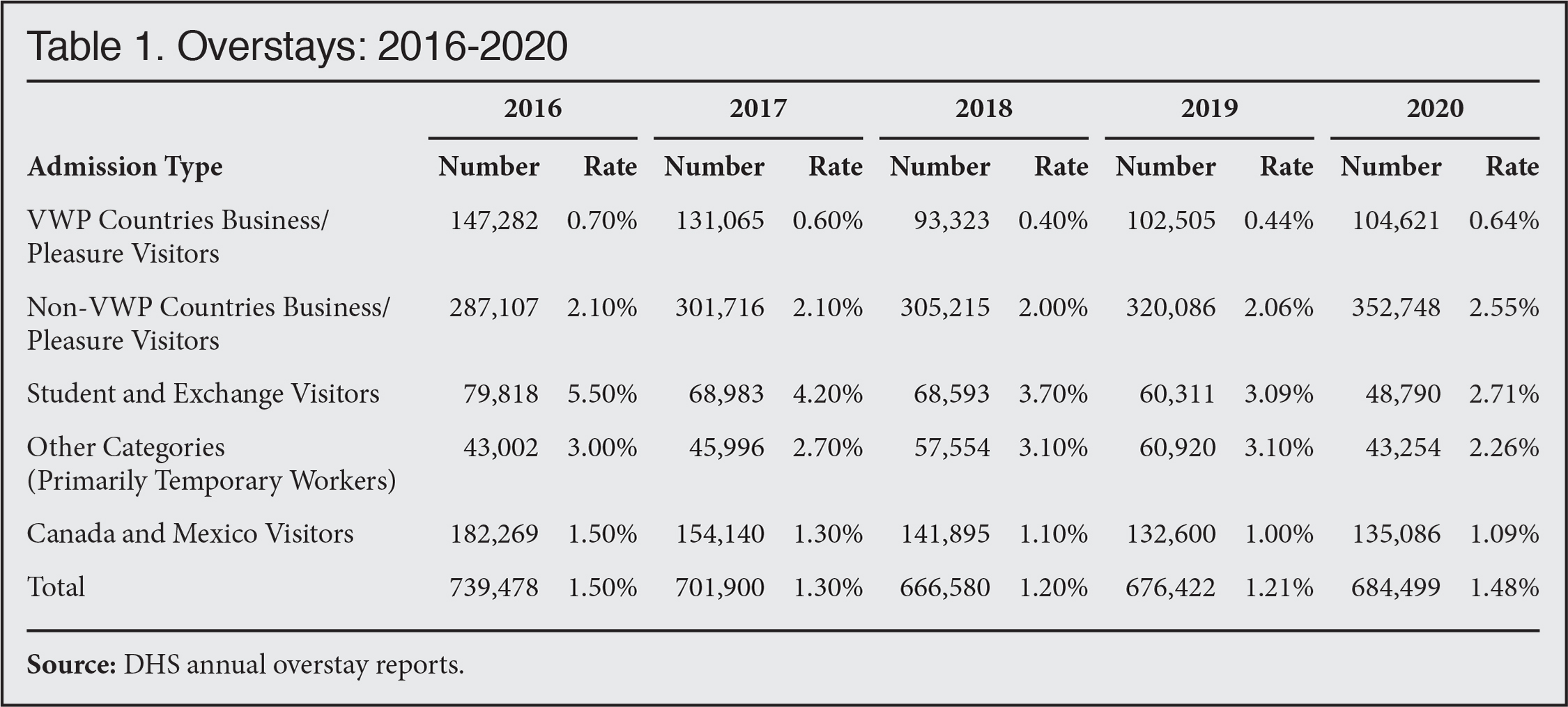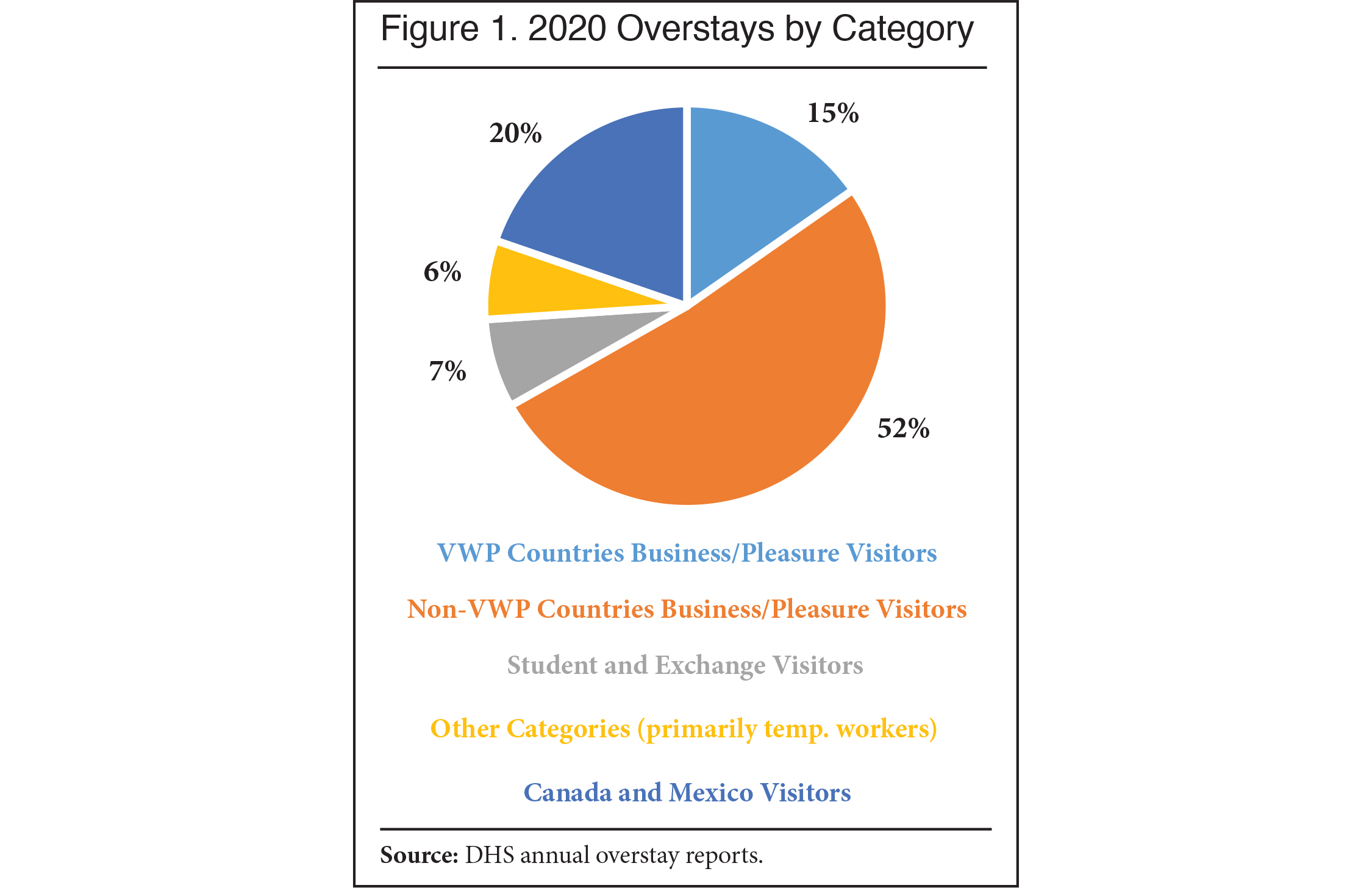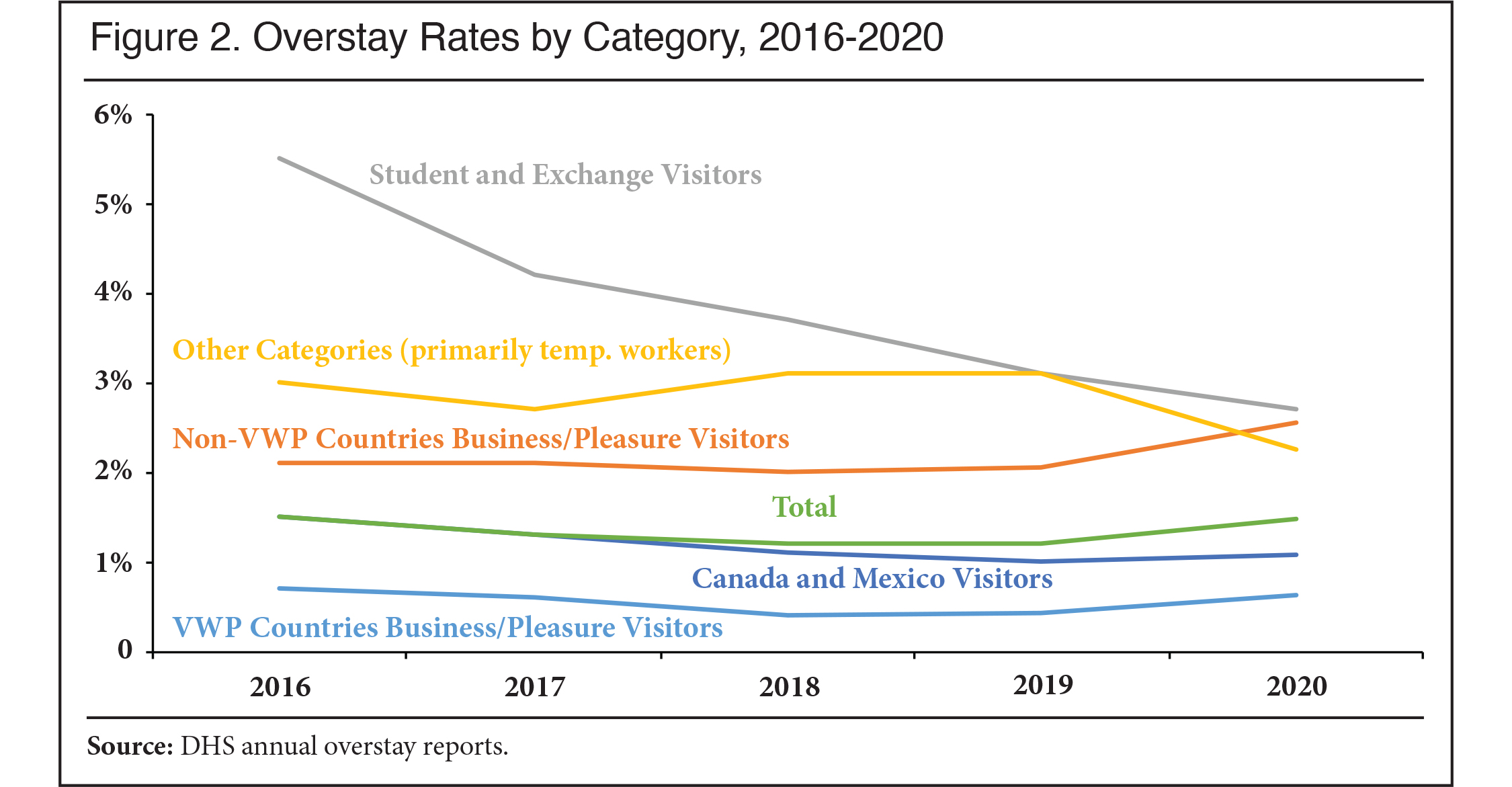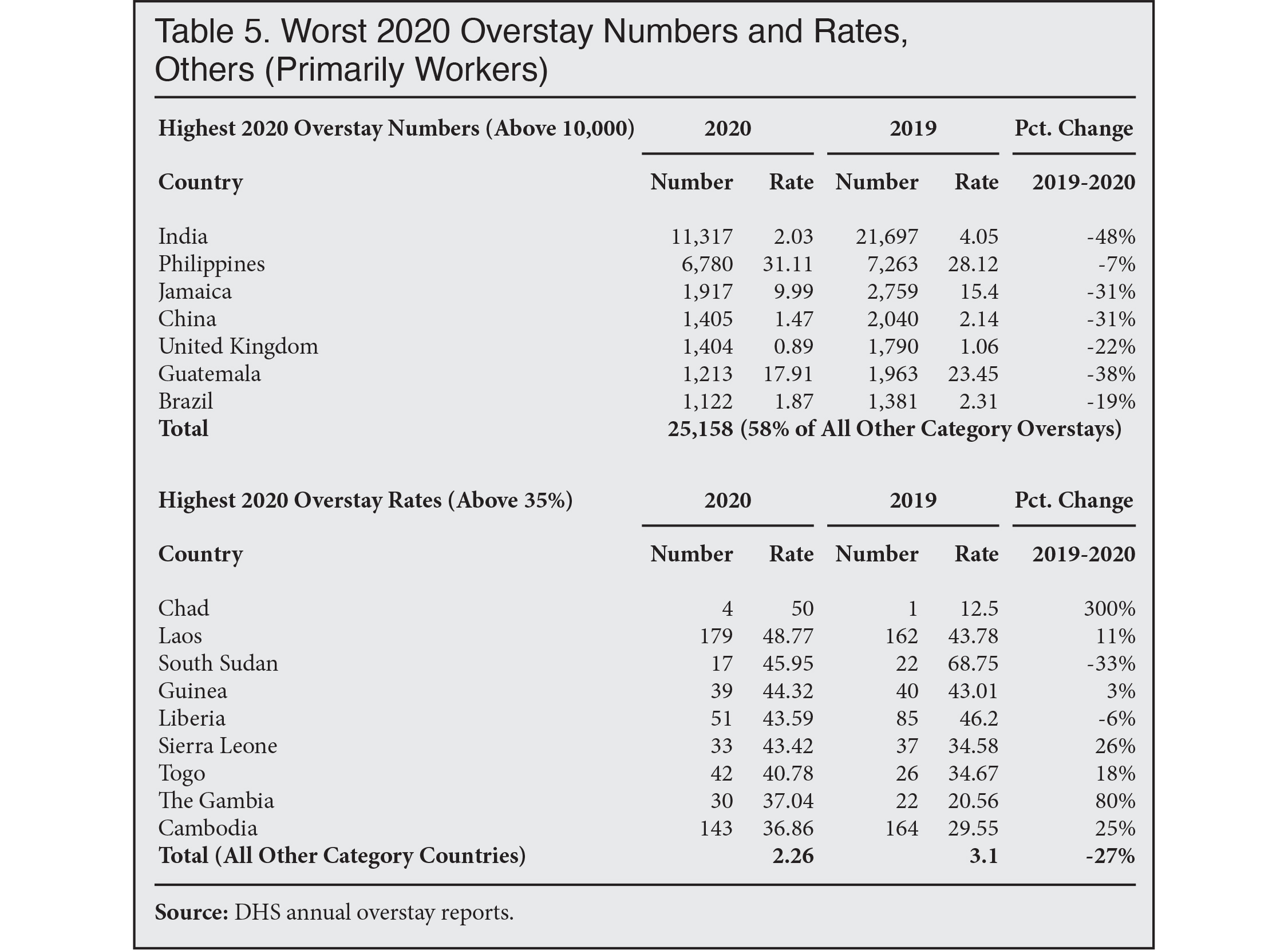Download a PDF of this Backgrounder.
Jessica Vaughan is the director of policy studies at the Center for Immigration Studies.
The recent arrest of Shihab Ahmed Shihab, a citizen of Iraq who arrived in the United States on a visitor’s visa in September 2020, filed an asylum claim just before his authorized duration of stay expired, and proceeded to work on a plot to assassinate former President George W. Bush, has once again raised questions about how our temporary visa vetting could have again failed so spectacularly.1 According to the Department of Homeland Security’s latest overstay report, more than 400 Iraqis overstayed visitor visas in 2020. While not all overstayers are terrorists, obviously, our temporary visa system repeatedly has been exploited by terrorists who overstayed. Besides, overstays are believed to be about 40 percent of the illegal alien population residing in the United States, contributing to illegal employment and undermining the integrity of our immigration laws. This Backgrounder examines the statistics published in the DHS report and offers recommendations to address the persistent problem of visa overstays — those foreign visitors who enter on a temporary visa and fail to depart within the authorized duration of stay.
The newest edition of the DHS overstay report has good news and bad news.2 Overall, the number of overstays in 2020 went up very slightly from 2019, as did the rate of overstays. This is bad news, considering that for half of the fiscal year international travel was drastically curtailed due to the pandemic and fewer visas were issued in the second half of the year. The good news is that the number and rate of student and exchange visitor overstays continued to decline significantly, and the number of temporary worker overstays also declined notably. The most concerning news is that short-term visitor overstays, which is by far the largest category, generating more than half of all overstays, worsened significantly. And certain countries and categories remain a problem, both in the number of overstays they generate and the poor rates of visa compliance.
To improve visa compliance and prevent visa overstays from contributing to illegal immigration, Congress should direct the executive branch to boost interior enforcement by Immigration and Customs Enforcement (ICE) and direct the State Department, which issues visas to foreign travelers, to take more vigorous steps to reduce approvals and improve vetting for categories of applicants who are most likely to overstay. Finally, Congress should consider creating and imposing more meaningful consequences for employers, schools, and other organizations that sponsor visitors who do not comply with visas.
Key findings:
- DHS counted 684,500 overstays in 2020, up very slightly (about 1 percent) from 2019, when 676,400 overstays were counted, and just below the levels in 2016 and 2017.
- Approximately 100,000 of people who overstayed had subsequently departed the United States by the end of the 2020 calendar year, leaving about 567,000 remaining in the country as overstays.
- The most problematic category of visitors for generating overstays is short-term visitors who enter on the standard “B” visa. More than half of all overstays are in this category (353,000 overstays out of 684,500), and these visitors have one of the worst compliance rates of the broad categories identified in the report.
- Student visa compliance improved considerably in 2020. There were nearly 49,000 student visa overstays in 2020, a drop of 39 percent since 2016. The student visa overstay rate declined by 50 percent between 2016 and 2020.
- Approximately 105,000 foreign visitors who entered under the Visa Waiver Program (VWP) overstayed in 2020, which is similar to the number in recent years. The United Kingdom had the most VWP overstays, while VWP travelers from Portugal had the worst rate of compliance.
- Compliance in the category that includes temporary workers improved considerably in 2020, with overstays dropping by nearly 30 percent from 2019, the largest drop in any category. This drop was driven primarily by a large decrease in overstays by citizens of India.
About the DHS Statistics
This report examines numbers, rates, and trends in overstays, primarily based on the total number of overstays reported by DHS by the end of the 2020 fiscal year. This metric of visa compliance permits comparisons between fiscal years, visa categories, and countries of citizenship. The DHS report covers only those visitors who enter and exit through the air and sea ports. Land entries and exits are not included because these entries and exits are not tracked to the same extent as air and sea entries.
It is important to note that the DHS statistics report overstay events, not individuals. However, it would be unlikely for one individual to overstay more than once in a year, since most visitors are authorized to stay at least six months and an overstayer who left and then attempted to return in the same year might be prevented from doing so by immigration authorities.
Because DHS counts events (entries and exits), not individuals, this produces overstay rates that are deceptively low, especially in the short-term visitor category. By far the largest number of entries are short-term visitors, either from VWP countries or on B visas. The majority of these visitors are people who enter and exit multiple times in one year, and are largely compliant. In contrast, overstays are assumed to occur typically on the person’s first visit within a year. So using this methodology, the frequent visits by millions of compliant travelers have the effect of suppressing the overall overstay rate. For example, if 10 people are admitted to the United States for three visits each and all are compliant, that is counted as 30 entries and departures. If an additional person is admitted and then overstays, that is counted as one entry without a departure. Using the DHS methodology, in this case the overstay rate would be 1/31 or 3 percent. If DHS instead counted individuals rather than entries and exits, the overstay rate would be 1/11, or 9 percent.
Total Overstays Increased in 2020
DHS identified 684,499 overstayed visits in 2020. This is a very slight increase of about 1 percent over 2019, and about 3 percent higher than 2018 (See Table 1). According to the report, about 83 percent of these overstayers (566,993) had no record of departure or legal status change by the end of the cut-off date for the study (the end of the fiscal year). About 17 percent (117,506) returned home shortly after overstaying.
 |
The increase in overstays occurred despite a decrease in the number of expected departures, likely due to fewer foreign visitors during the pandemic travel restrictions, which began halfway through the fiscal year. In 2019, DHS reported the number of expected exits of foreign visitors to be about 56 million. In 2020, only about 46 million exits were expected — but there were more overstays that occurred. The number of expected exits can be considered a proxy for the number of new visits in the VWP category, the regular short-term visa category, and the visits from Canada and Mexico, because unlike the student and worker visa categories, these are all categories of visits that would last less than one year.
Most of the decline in foreign visitors was due to fewer VWP visitors; this number dropped by 30 percent in 2020, from about 23 million in 2019 to about 16 million in 2020.
The largest number of overstays are visitors arriving with short-term visas, followed by Canadian and Mexican visitors, and then Visa Waiver Program visitors.
 |
Overstays increased the most in the short-term visa visitor category. The number of short-term visitor overstays went up 10 percent, and the overstay rate in this category went up 24 percent. This is concerning because this category brings in the largest number of visitors by far.
The number of overstays decreased most significantly in the student/exchange visitor and temporary worker categories. Student/exchange visitor overstays fell by 19 percent, and the rate of overstay dropped 24 percent. Temporary worker overstays fell by 29 percent, and the rate of overstay fell by 27 percent.
 |
Visa Waiver Program Compliance Does Not Improve
The Visa Waiver Program (VWP) allows nationals of 40 countries to travel to the United States for tourism or business for a period of up to 90 days without obtaining a visa.3 Countries in the VWP have met various requirements set forth by the U.S. government, such as low rates of unqualified applicants, e-passports, enhanced law enforcement and security-related data sharing with the United States, and high security standards for customs and border security. In addition, travelers are pre-screened through an electronic registration system known as ESTA (Electronic System for Travel Authorization), and those who are not approved after the ESTA background check are supposed to apply for a visa before they can be granted admission.
VWP overstays make up 15 percent of all overstays. Because the participating countries must demonstrate that a high percentage of likely travelers are qualified to be admitted to the United States (as measured by a history of low visa refusal rates), it is not surprising that the VWP overstay rate is the lowest of all the broad categories identified in the DHS report (0.64 percent in 2020), even though the number of visits in 2020 (over 16 million) is the highest of any category.
Table 2 shows the VWP countries with the most overstays and the worst rates of compliance.
 |
Two VWP countries, Portugal and Brunei, had overstay rates over 2 percent, triggering a requirement for these governments to take steps to reduce those rates or face removal from the program. This is not the first year that Portugal has hit this threshold, raising questions as to their suitability to remain in the VWP. Fortunately, the number of overstays from Portugal is not very large (just over 3,000 in 2020), but likely are somewhat concentrated in certain areas of the United States, such as New England.
Short-Term Visa Category Produces the Most Overstays
Citizens of non-VWP countries, which is most of the world, must obtain a visa to travel to the United States. There were fewer expected exits in this category (about 14 million) in 2020 than in the VWP category, but there were more than triple the number of overstays.
Table 3 shows the non-VWP countries with the most overstays and the highest overstay rates in 2020. In 2020, the largest number of overstays were citizens of Brazil, although of the top countries, Venezuela, Nigeria, and Haiti had much higher overstay rates than Brazil. Several countries — especially Haiti, India, Ecuador, and China — had increases in the number of overstays in excess of 20 percent.
 |
A number of countries have very high overstay rates (above 15 percent), with four countries over 20 percent: Chad, Sudan, Djibouti, and Mauritania. These countries have a small number of visitors, but still these overstay rates indicate that the State Department should be stricter in vetting and in setting standards for approval.
Student and Exchange Visas Have Highest Overstay Rates, but Improved
DHS reported that in 2020 it expected approximately 1.8 million departures by visitors who had entered on student or exchange visitor visas. The vast majority entered on regular “F” student visas, rather than as “J” exchange visitors or “M” vocational students.
This category produced roughly 49,000 overstays, resulting in an overstay rate of 2.7 percent, the highest of any category of visas in 2020. However, both the number and the rate of student and exchange visitor overstays were significantly lower than they have been in the last several years. And the DHS report shows that a large percentage of overstays in this category (43 percent) had already left the country by the end of the fiscal year, when the count was completed, and thus are no longer a problem.
The country with by far the most overstays in 2020 was China, with nearly 11,000. This is more than one-fifth of all student/exchange visa overstays, and 32 percent higher than the number of Chinese overstays in 2019. Just five countries were responsible for 45 percent of all student and exchange visa overstays (see Table 4).
 |
While student and exchange visitors had much better compliance rates in 2020 than in recent years, there are some countries that still have very poor rates of compliance, with double-digit overstay rates (though fortunately few in number). Some of these are countries associated with terrorism, such as Yemen and the Democratic Republic of Congo (formerly Zaire). These very high rates of non-compliance suggest that the State Department at the very least should scale back student and exchange visa issuances in these countries, if not suspend them entirely until the overstay rates improve. In addition, Immigration and Customs Enforcement (ICE), the agency responsible for taking enforcement action on overstays, should implement more rigorous monitoring of students from these countries.
Temporary Worker Overstay Rates Are High, but Improved the Most
The DHS report also includes statistics on overstays in a category called “All Other In-Scope Non-immigrants”. This category consists of various non-immigrant categories, the great majority of which are temporary workers and other employment-related visas, and a few “pre-immigrant” categories such as fiancés of U.S. citizens (which comprise much smaller numbers).
This category showed the most improvement in visa compliance of all the broad categories. The number of overstays dropped by 29 percent from the prior year, and the overstay rate dropped by a similar amount, even though the number of expected departures was about the same. This decrease was driven primarily by a drop in the number of overstays from India, which declined by about half — resulting in about 10,000 fewer overstays than in 2019.
The report shows concerning high overstay rates from certain countries that participate in specific work visa programs at particularly high rates. For example, citizens of the Philippines receive the largest number of ship crew visas (known as C-1/D visas). The State Department issued 73,000 of these to Filipinos in 2019.4 This is higher than any other category of work visa, and it appears that crew members jumping ship might be the reason for the very high overstay rate (31 percent) and high number (6,780) of Filipino work visa overstays in 2020.
In addition, the statistics indicate that Guatemalans are overstaying temporary work visas in significant numbers (1,213) and at high rates (18 percent). Most Guatemalan temporary workers are admitted in the H-2B program for unskilled seasonal workers. Certain other countries have very high work visa overstay rates, but in relatively low numbers (See Table 5).
 |
Policy Recommendations to Address Overstays
Congress has been pressing for action on overstays periodically for 25 years, ever since the post-1993 World Trade Center terror attack investigations revealed that an estimated 40 percent of illegal alien residents are visa overstays. The annual overstay report provides an empirical basis for law and policy adjustments that can be made by Congress and the executive branch.
First, the State Department must adjust issuance standards and processes in order to give out fewer visas to applicants in countries and/or categories with poor compliance, aided by deep analysis of overstay patterns and case studies. Further, leadership in the Bureau of Consular Affairs, consular managers, and individual officers should be held accountable for excessive visa overstay rates.
In addition, DHS should end the practice of giving every short-term visa holder a default six-month duration of stay. Instead, the routine admission should be no more than 30 days, unless the traveler can show a credible reason for staying longer. Similarly, the duration of stay for Mexicans using the much-abused Border Crossing Cards intended for shopping and quick visits should again be restricted to 72 hours.
While policy tweaks will help, the most effective way to deter overstays is to reduce the incentives and increase the risk of consequences. If overstayers cannot avoid attracting attention, and cannot easily get a job, a driver’s license, and other benefits, there is little point to remaining illegally, and they will comply with the visa or not come in the first place. Preventing illegal employment through expanded use of E-Verify and more ICE workplace enforcement and discouraging sanctuary policies would increase the risks and lessen the appeal of overstaying a visa.
For those foreign visitors who will not be deterred from overstaying, there must be more effective enforcement in the interior of the country. The main problem is that it is not a priority for the agency responsible for overstay enforcement. Overstay enforcement was not even mentioned as part of ICE’s mission, much less as a priority, in the ICE director’s annual report in 2021.5 A search of ICE deportation records for 2021 turned up a total of 59 deportations of apparent overstays resulting from investigations by Homeland Security Investigations — out of the nearly half-million non-departed overstays that DHS counted in 2020 alone.6
Not only should ICE be directed to devote more resources to overstays, Congress should make changes to the law that would assist ICE in addressing the problem. Unlike illegal border-crossers, who often can be processed administratively by immigration officers upon arrest, visa overstayers are entitled to more generous forms of due process, including a hearing in immigration court and the opportunity for protracted appeals. Our immigration courts now are so dysfunctional that the proceedings for the average overstayer arrested today likely will take at least several years. Congress should correct this disparity, perhaps by requiring that certain visa holders waive their rights to a court hearing as a condition of admission, as is the case for those entering under the Visa Waiver Program, so that they can be removed more expeditiously.
Finally, those who profit from the visa programs that produce too many overstays — whether they are employers, exchange programs, schools, or labor brokers — should be subject to consequences, including debarment from sponsoring foreign students, exchange visitors, or workers, and potentially sanctions, fines, or other civil and/or criminal penalties.
The travel sector, certain employer groups, and the education industry have been lobbying the president and Congress to issue more visas for students and guestworkers, expand visa waivers, and back off reforms to exchange programs. The Biden administration already has implemented several changes to make it easier for temporary visitors to get visas and remain in the United States.7 Congress should avoid any further expansion or relaxation of visa issuance policies until the laws can be improved and the executive branch can show that visa overstays have been significantly reduced.
End Notes
1 Todd Bensman, “About the Iraqi Asylum Seeker Who Allegedly Wanted to Import an ISIS Terrorist Hit Squad”, Center for Immigration Studies, May 27, 2022. See also the criminal complaint.
2 “Fiscal 2020 Entry/Exit Overstay Report”, Department of Homeland Security, September 30, 2021. Note: The report is dated September 30, 2021, but was not released to the public until January 2022, after several members of Congress questioned DHS Secretary Mayorkas about the delay in releasing it. The required 2021 report is now also overdue.
3 For a list of these countries, see “Visa Waiver Program”, U.S. State Department.
4 Table XVII, “Report of the Visa Office 2019”, U.S. State Department.
5 “ICE Annual Report, Fiscal Year 2021”, U.S. Immigration and Customs Enforcement, March 11, 2022.
6 A search of ICE deportation records for 2021 obtained by FOIA turned up 59 removals of apparent non-immigrant overstays resulting from ICE investigations. They included two aliens who entered on Border Crossing Cards, 45 general non-immigrant visa holders, 10 student visa holders, one temporary work visa holder, and one who entered under the Visa Waiver Program.
7 See Robert Law, “President Biden’s First 100 Days: Swift Action to Change Immigration Policy”, Center for Immigration Studies, April 27, 2021.
